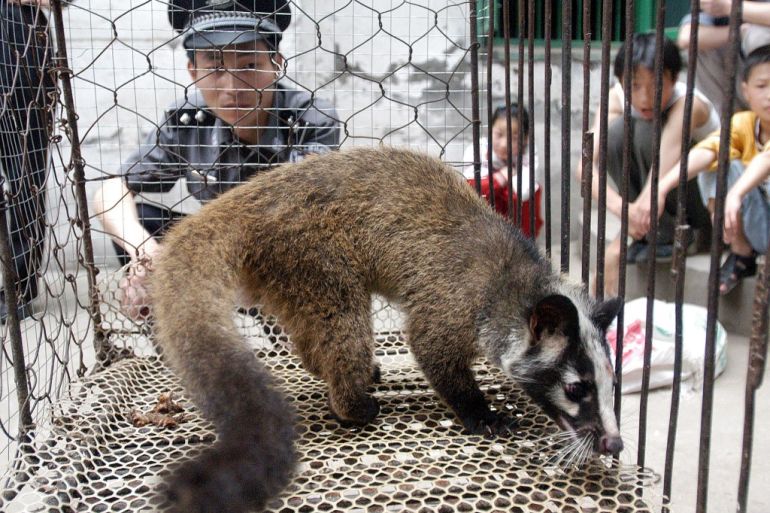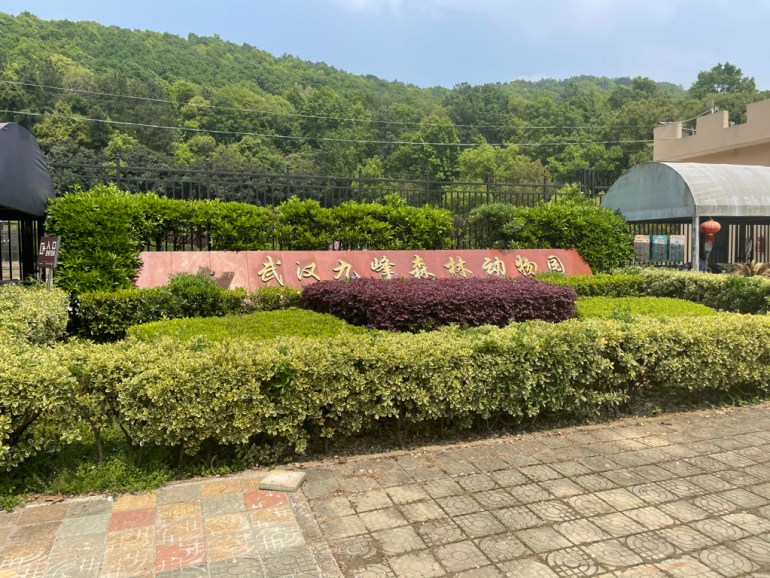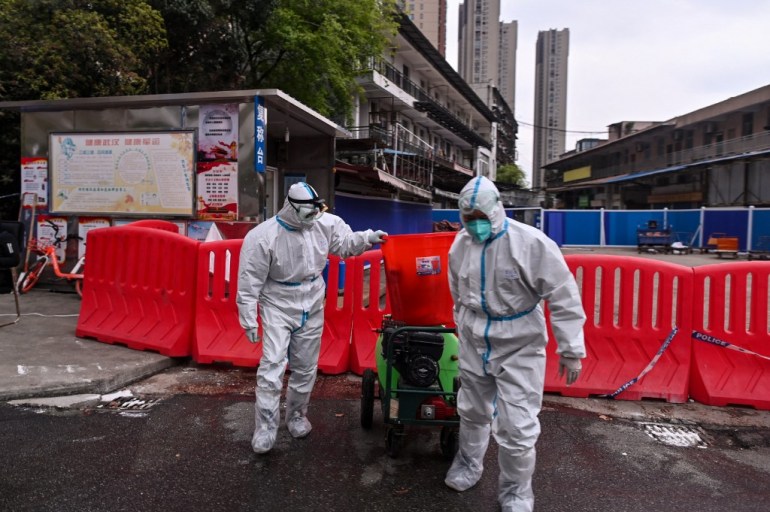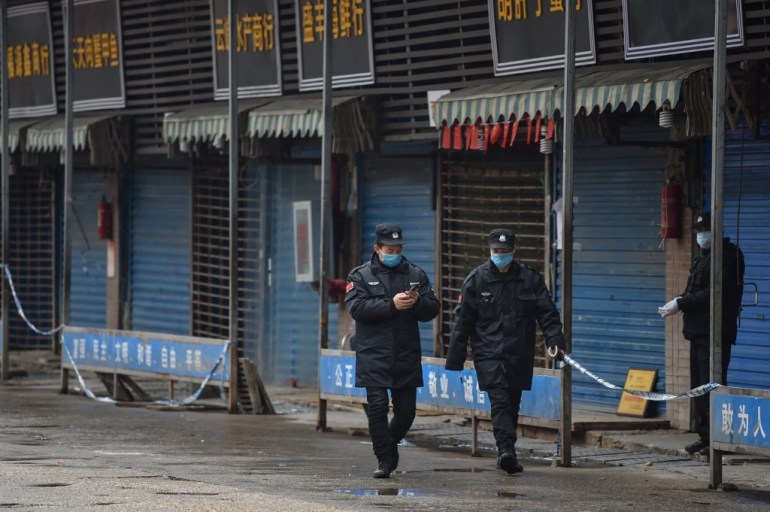Wuhan facilities shed light on China’s oversight on wildlife use
G7 leaders call for ‘a transparent, evidence-based’ study on the origins of COVID-19 but Beijing is rejecting another probe.

Wuhan, China – Arriving at the gate to the Hubei Wildlife Rescue Centre on the east side of the Chinese city of Wuhan near its famous lakes, you can hear the continuous squawking of birds and a cacophony of noises from the other animals inside.
On the building to the left of the gate a sign prominently advertises the centre’s affiliation with the Wuhan Institute of Virology (WIV), one of two biosecurity laboratories in the city that have been thrust into the spotlight, in an increasingly fractious debate over the origin of COVID-19 – a virus that has now killed more than 4.47 million people around the world.
Keep reading
list of 3 itemsChina’s Wuhan to test ‘all residents’ as COVID-19 returns
COVID-19 origins: China rejects WHO proposal to return to Wuhan
According to documentation from the centre, it houses several veterinary clinics, monkey facilities, pens for amphibians and reptiles, wildlife breeding facilities and an animal hospital. Netting to keep birds and other animals from escaping is visible along the fence.
The rescue centre, in a hilly area in the Hongshan district, is next door to a private zoo, Jiufeng Forest Zoo, which was shut the day before Wuhan was locked down in January 2020 to prevent the spread of the coronavirus.
More than 18 months later, as G7 leaders call for “a transparent, evidence-based and expert-led World Health Organization or WHO-convened phase 2 study on the origins of COVID-19, that is free from interference” and intelligence services in the United States reveal their findings on the origins of the virus, it remains unclear as to whether the wildlife centre or the zoo were ever questioned as part of investigations into how the disease emerged into the world.
Repeated requests since March to representatives of the Jiufeng Forest Zoo and the companies connected to it – the Hubei Wildlife Rescue Centre, the Wuhan Institute of Virology [WIV], the provincial forestry bureau and forestry university – for further information about activities at these two facilities, which are on property owned and overseen by the Hubei Forestry Bureau and the Hubei Forestry University were declined.
While there is no known link between the COVID-19 outbreak and the Hubei Wildlife Rescue Centre, the failure of authorities to explain its connections to the WIV, what research was being conducted there and on what animals, as well as its relationship with the Jiufeng Forest Zoo next door, raises questions about its wildlife utilisation practices and potential conflicts of interest related to the investigation into the origins of the outbreak.
Scrutinising the links
The wildlife rescue centre has partnered with WIV on research into zoonotic viruses since 2013, and has a history of promoting the use of wildlife and breeding hybrids of wild animals. More than 200,000 wild animals from 89 different species have been housed at the facility or passed through its gates since it opened in 2000, according to its website.
Kristian Andersen, an infectious disease expert at the United States’ Scripps Research Institute, who believes that the Huanan seafood market and other markets in Wuhan were the most likely source for both the original outbreak and its later amplification, says there needs to be a broader understanding of what was going on in Wuhan in the autumn of 2019 related to wildlife use.
“These types of activities ongoing on a daily basis like wildlife handling and the wet markets and things like that are very high risk [in terms of zoonotic virus transmission],” he told Al Jazeera.
“We need to get a better sense of those streams outside the market, and how did they lead to the market.”
According to the joint China-WHO report that was released in March, there were no live wild mammals at the Huanan market when inspectors from the Wuhan forestry bureau, the Wuhan forest police, the local centre for disease control and prevention and local market supervision authorities arrived on 31 December 2019, before shutting it down on 1 January 2020.

But a report published in Nature Scientific Reports earlier in June found “47,381 individuals from 38 species, including 31 protected species sold between May 2017 and November 2019 in Wuhan’s markets”.
“Almost all animals were sold alive, caged, stacked and in poor condition,” it added. Though bats and pangolins were not among the species identified, there were marmots, raccoon dogs, civet cats, badgers and wild birds. Both raccoon dogs and civets were implicated in the emergence of SARS back in 2002 and 2003.
Only 31 farms in Hubei province were checked to see if COVID-19 emerged from wildlife there after April 2020, according to the joint WHO study, although the province is known to have hundreds of breeders.
One area of Western Hubei alone was home to 290 farms with between 450,000 and 780,000 wild captive-bred animals at the start of the outbreak, according to several official government notices issued early in 2020.
‘Hybridisation experiments’
Yang Guoxiang, director of wildlife disease and surveillance at the rescue centre, was one of five Chinese team members on the WHO-convened study team investigating the animal origins of the SARS-CoV-2 virus. He was also involved with initial testing around Wuhan and, after the city was lifted from lockdown, wider sampling at captive-bred wildlife farms in Hubei.
Reached by mobile phone from outside the facility, he declined to talk about the activities of the centre, saying he does not “speak to foreign press”.
"I was one of the experts who visited Wuhan earlier this year as part of the WHO’s investigation into [COVID-19's] origins. We found the evidence pointed to… spillover from an animal to humans."@Sydney_Uni's Dominic Dwyer says more research is urgent.https://t.co/x0VywUURNw
— The Conversation (@ConversationEDU) August 26, 2021
Repeated requests to discuss the centre’s work have been declined.
Several scientific papers show that Yang has promoted the use of Asiatic black bile for traditional Chinese medicine and worked on a paper involving experiments related to the breeding of mink, a species known to be highly susceptible to SARS-CoV-2.
According to a brief report from the state-run Xinhua news agency, the wildlife rescue centre in Wuhan has, since 2007, carried out a variety of artificial hybridisation experiments, with 30 hybrid varieties developed, although only ducks were mentioned in the report.
Though the centre hosted a wide range of animals, there was apparently poor security at the facility. Over the course of six years, one monkey became famous for repeatedly escaping and being recaptured, with several state media reports quoting Yang on the case in 2015.
‘Smuggled pangolins’
Wildlife rescue centres across China have also been implicated in facilitating the movement of protected wildlife directly to holders of wildlife utilisation licenses approved by forestry administration bureaus across the country.
In one 2018 case, 33 live pangolins that had been smuggled into the country were seized and later turned over to a forestry department-run wildlife rescue centre in Guangxi province. The pangolins died in captivity and were later sold to companies holding licences to use pangolins, including a steel company.

The China Biodiversity Conservation and Green Development Foundation [CBCGDF], a conservation organisation based in Beijing, brought the issue to light and has been battling with the centre for greater transparency about those transactions ever since.
For Debbie Banks, campaign leader for tigers and wildlife crime at the Environmental Investigation Agency in the UK, China’s opaque licensing process is one of the key factors in the continued misuse of wildlife.
“The lack of transparency and lack of inspections means that there is this lack of accountability and oversight as to what is happening [with wildlife], and what species are being licensed or traded by what companies,” Banks said.
EIA tries to follow some of the licensing by tracking regulatory activity online. It often sees licences going to companies previously involved in domestic wildlife trade, and for Banks, in particular, that means licences related to the tiger trade.
“So we’re kind of left in the dark about what these new licences are for, what these new permits are for, and it throws up more questions than it does answers,” Banks said.
In another case in late 2020, a whistle-blower posted images online alleging tiger skins, tiger bone wine and meat from slaughtered tigers were being sold for profit from the Qinhuangdao Wildlife Rescue Centre in Hebei province near Beijing. The centre was originally founded by the China Wildlife Conservation Association and was also set up directly next to a wild animal park, just like the facility in Wuhan.
“For a long time there has been a lack of transparency related to wildlife rescue centres,” Linda Wong, deputy secretary-general of the CBCGDF, said. “But we have pushed for that to change.”
Further problems related to what happens when wildlife or their parts are seized were evident in a case in 2018 where three tonnes of pangolin scales intercepted by customs officers were later sent to Northeast Forestry University in Heilongjiang, the previously mentioned forestry administration-run university.
A further 11 tonnes of scales seized in Shenzhen were meant to be transferred there for “scientific research” until CBCGDF and other conservationists drew attention to the transfers.
While the trade of pangolin scales has been driven by demand from the traditional medicine industry in China, there is no scientific evidence they provide any health benefits. The scales are made up primarily of keratin, a substance that also makes up human fingernails and hair, and which can also be produced from a range of other sources.
No wonder they haven't found any positive SARS-CoV-2 on wildlife farms in China. They only sampled around 3,000 animals at 31 captive breeding facilities … pic.twitter.com/BrE7HsUxXt
— Michael Standaert (@mstandaert) April 3, 2021
The zoo
Abutting the wildlife rescue centre in Wuhan, a short walk up a winding road, is Jiufeng Forest Zoo, home to red pandas, lions, tigers, pigs, rabbits, camels and a variety of other wildlife. The zoo remains closed even though life in Wuhan returned to normal months ago.
No one at the zoo would talk about the shutdown and why it had not reopened when Al Jazeera visited, nor during later attempts by phone and email.
A minority shareholder in the zoo is Guilin Xiongsen Bear and Tiger Mountain Village, a facility in Guangxi set up to breed tigers that has been targeted in the past by wildlife conservation groups due to its connections to the production and sale of tiger bone wine and other products from tiger parts.
The zoo was built as a joint project between the Hubei Forestry Academy and the owners of the tiger breeding operation in Guangxi.
The owner of the Xiongsen companies, Zhou Weisen, has been involved in tiger breeding since the late 80s, and became a prominent lobbyist for the wildlife utilisation industry over that time, according to wildlife conservationists like Wong.
While the tiger village in Guangxi shut down for renovations in 2018, it is currently being rebuilt in another location nearby, complete with a large residential complex, schools and other facilities.
Zhou’s tiger village is also an official research base for Northeast Forestry University and Zhou partners with a tiger breeding facility also connected to that university in Heilongjiang.

The ‘father of wildlife utilisation’
Northeast Forestry University is home to the Wildlife Resource College founded by Ma Jianzhang, sometimes called “the father of wildlife utilisation” in China, due to his promotion since the early 1980s of the commercialisation of wildlife resources.
Ma has long been heavily influential in lobbying leaders in Beijing to keep utilisation at the forefront of various laws on the protection of wildlife, and has been behind efforts to breed tigers [never successfully reintroduced into the wild in China], and rhinos, as well as for allowing permits for foreigners to hunt in certain parts of China.
In 2018, China lifted a ban on the use of tiger parts and rhino horn in traditional medicine that had been in place since 1993, and while the central government later backtracked and said it had “postponed” implementing the regulation, the policy has not been officially rescinded. Some in the wildlife protection community believe both Zhou and Ma were influential in pushing for the lifting of the ban.
“Their influence on policy is great,” Wong of the CBCGDF said.
The college Ma founded to promote a concept of “wildlife management science,” a centre he established to train officials, and the books he has produced have influenced a generation of China’s wildlife management officials, according to Peter J Li, author of Animal Welfare in China.
By promoting “reasonable use” of wildlife – and getting the backing of the highest levels of officialdom – Ma and others within the forestry administration were given the green light to develop wildlife domestication, although it never had a history in Chinese culture, particularly on the massive scale that has been promoted over the past few decades, Li argues.
According to Li, who works for Humane Society International, this straddling of protection and use intimately connects the bureaucratic interests of national and local forestry bureaus with the interests of the wildlife industries.
While the authorities have moved to halt the farming and consumption of meat from wildlife since the outbreak of COVID-19 – a process which included the culling of an unknown number of animals across the country early in 2020 – the fur industry and animals bred for traditional Chinese medicine remain largely unregulated and protected.
Ma, who did not respond to interview requests, was behind a widely cited report in 2017 claiming that the wildlife industry in China employed 14 million workers. That report also claimed the industry generated revenues of about $50bn for fur farming, about $20bn in revenue related to breeding wildlife for meat, and about $5bn for traditional Chinese medicine, although organisations such as CBCGDF claim the numbers have been inflated to give the industry more lobbying clout.
In 2018, China’s top decision-making body the State Council included wildlife domestication in Document No 1 – an important document released each year which focuses on rural development – for the first time.
That promotion of the wildlife trade was also directly part of the overall effort to eliminate absolute poverty in rural areas of China, which saw the wildlife trade boom over the past several years as local governments looked to promote new forms of income for local families.
While virologists and other wildlife experts consulted for this story could not say for certain that there were problems at the zoo and rescue centre, they do believe it is essential for the investigation into the origins of SARS-CoV-2 to have detailed information about what animals were at those facilities in the months leading up to the outbreak, especially high-risk species such as pangolin, mink, civet cat, ferret badgers and raccoon dogs.
“As nearly all human viruses have jumped from animals it is obviously critical to know what wildlife were in Wuhan at the time the virus emerged and to survey them for SARS-CoV-2. To me, this should be step number one in trying to understand how this virus originated,” said Edward Holmes, an expert in virus evolution from the University of Sydney.
This story was supported by funding from the Internews Earth Journalism Network